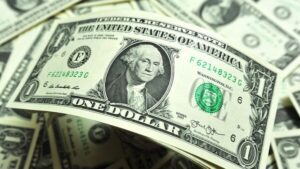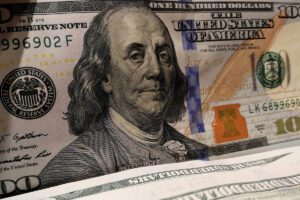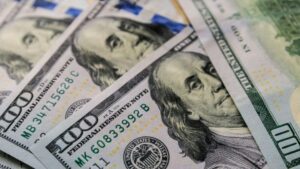
The U.S. dollar is strengthening against the euro, the yen and the pound sterling in trading on Tuesday amid market revisions of expectations for the Federal Reserve (Fed) rate peak.
The ICE-calculated index showing the dollar’s performance against six currencies (euro, Swiss franc, yen, Canadian dollar, pound sterling and Swedish krona) added 0.17% in trading, while the broader WSJ Dollar Index gained 0.16%.
The euro/dollar pair is trading at $1.0585 as of 8:15 a.m., up from $1.0611 at Monday’s market close.
The pound exchange rate had dropped to $1.2041 by that time from $1.2065 the day before.
The value of the American currency against the yen is 136.31 yen against 136.23 yen at the end of the previous session.
The futures market expects the Fed’s rate to peak at 5.4% this year, although a month ago the maximum rate was estimated at 5%, Bloomberg noted.
The adjustment of traders’ expectations is related to signals of the sustainability of inflation in the U.S. According to the data published on Friday, the consumer price index (PCE index) in the states in January increased by 0.6% against the previous month (the maximum increase for six months), and in annual terms it rose by 5.4%. The rate of growth accelerated compared to December, when it was 0.2% and 5.3%, respectively.
Statistical data from the euro zone, to be released Thursday, are expected to show some easing of inflation in the region in February. The consensus analyst forecast cited by Trading Economics expects the euro area’s consumer price growth rate to slow to 8.2% on an annualized basis this month from 8.6% in January.
However, the rate of consumer price growth excluding food and energy (CPI Core, a core inflation indicator) is expected to remain at 5.3%, a record high.
The swap market expects the ECB deposit rate, currently at 2.5%, to rise to 3.9% in February 2024.

The ICE-calculated index showing the dollar’s dynamics against six currencies (euro, Swiss franc, yen, Canadian dollar, pound and Swedish krone) is losing 0.03% in trading, while the broader WSJ Dollar Index is stable.
The minutes of Wednesday’s Jan. 31-Feb. 1 U.S. Central Bank meeting showed that Fed policymakers plan to continue raising rates, believing that current levels are not enough to curb economic activity to beat inflation. At the same time, they believe that the cycle of rate hikes could be completed this year.
According to the minutes, meeting participants also noted that the restrictive policy will need to be maintained until the Central Bank has “confidence that inflation is on the path to a steady decline to the 2% level.”
Eurozone inflation stats released Thursday confirmed investors’ view that the European Central Bank will continue to tighten policy sharply.
According to final data from the European Union Statistical Office (Eurostat), consumer prices excluding food and energy (CPI Core Index, an indicator of core inflation) rose at a record annual rate of 5.3% in January. They had been previously reported to have risen 5.2% in January, and analysts did not expect the data to be revised.
The estimate for consumer price growth as a whole was revised to 8.6% annualized from the previously announced 8.5%, Eurostat said.
The euro/dollar pair was trading at $1.0603 as of 8:15 a.m., up from $1.0596 at market close on Thursday.
The pound is at $1.2023 from $1.2013 the day before.
The U.S. currency fell to 134.58 yen against 134.68 yen in trading during the previous session.
Kazuo Ueda, who was nominated as the head of the central bank by the Japanese government said during his speech in the parliament on Friday that he considered it reasonable to keep ultra soft monetary policy in Japan in order to achieve the central bank’s inflation target. At the same time, he made it clear that he sees various options for controlling the yield curve of government bonds in the future.

The world’s largest cryptocurrency exchange, Binance, is imposing a ban on dollar deposits and withdrawals, the company said in a statement, without specifying the reasons for the decision.
“We are temporarily suspending bank transfers in dollars as of Feb. 8,” said a Binance spokesman quoted by CNBC.
He added, however, that the company is working to resume these transactions as soon as possible.
Binance US, which is regulated by the U.S. Treasury’s Financial Crimes Enforcement Network (FinCEN), said in a statement posted on Twitter that the decision to suspend operations has not affected it. Thus, it only affects users outside the U.S. who transfer dollars to or withdraw dollars from bank accounts.
Binance’s announcement triggered a surge in cash outflows from the exchange’s cryptocurrency wallets, according to Arkham Intelligence.
Net cash outflows from the exchange exceeded $172 million in one day, according to DefiLlama. By comparison, the company has $42.2 billion in cryptocurrency assets, so the outflow is negligible, Arkham noted.

The ICE computed index showing the dollar’s trend against six currencies (euro, Swiss franc, yen, Canadian dollar, pound and Swedish krona) gained 0.15%, while the broader WSJ Dollar Index gained 0.09%.
The ICE dollar index jumped more than 1 percent Friday following the release of U.S. economic data showing that the U.S. labor market remains strong, leaving ample room for the Federal Reserve (Fed) to maneuver further tightening monetary policy.
According to the U.S. Labor Department, the number of jobs in the U.S. economy increased by 517,000 in January and unemployment fell to its lowest level since 1969, 3.4%.
This week, traders will be waiting for more signals from Federal Reserve (Fed) Chairman Jerome Powell, who will speak at the Economic Club in Washington on Tuesday.
During a press conference on the results of the January 31-February 1 meeting of the U.S. Central Bank, Powell acknowledged for the first time that “the disinflationary process has begun. He also suggested that the Fed rate, which was raised to 4.5-4.75% at the end of the meeting, would not exceed 5%, and reiterated that the Fed could achieve slowdown in inflation without causing significant harm to the economy.
The euro/dollar pair is trading at $1.0797 as of 7:55 a.m., up from $1.0799 at the close of the previous session.
The pound is at $1.2062, compared to $1.2056 at the close of the previous session.
The dollar rose to 131.71 yen against 131.18 yen the day before.

The U.S. dollar is stable against the euro and the pound on Monday morning and is weakly falling against the Japanese yen in anticipation of this year’s first meetings of the Federal Reserve, the European Central Bank and the Bank of England.
The ICE-calculated index showing the U.S. dollar’s performance against six currencies (euro, Swiss franc, yen, Canadian dollar, pound sterling and Swedish krona) is down less than 0.1% in morning trading.
The euro/dollar pair is trading at $1.0866 as of 7:47 a.m., versus $1.0869 at the close of last Friday’s session.
The dollar/yen exchange rate is down 0.1% at 129.70 yen, down from 129.85 yen at the close of trading on Friday.
The pound is trading at $1.2394 versus $1.2396 at the close of last session.
The Fed will release the results of its meeting on Wednesday, February 1. Analysts expect the Fed leadership to raise the key interest rate by 25 basis points, meaning the hike will be more moderate than at previous meetings.
Market participants will also closely follow the speech of Fed Chairman Jerome Powell, hoping to get new signals on the future trajectory of monetary policy.
Last week, it became known that growth in the Core Consumer Price Index (Core PCE), which the Federal Reserve closely monitors when assessing inflation risks, slowed to 4.4% in December from 4.7% in November, marking a fourteen-month low.
The outcome of the ECB and Bank of England meetings will be known on Thursday. Experts expect both central banks to raise interest rates by 50 bps.

The U.S. dollar is getting stronger against the euro and the pound sterling in trading on Friday, getting cheaper against the yen.
The ICE-calculated index showing the dollar’s performance against six currencies (euro, Swiss franc, yen, Canadian dollar, pound sterling and Swedish krona) gained 0.11%, while the broader WSJ Dollar Index gained 0.07%.
The euro/dollar pair was trading at $1.0871 as of 8:20 a.m., up from $1.0892 at the close of the previous session.
The pound was down to $1.2380 from $1.2410 the day before.
Statistical data published on Thursday showed that the U.S. economy remains resilient despite a significant tightening of monetary policy by the Federal Reserve (Fed).
According to preliminary data from the U.S. Commerce Department, the nation’s GDP rose 2.9% on an annualized basis in the fourth quarter after climbing 3.2% in the previous quarter. The consensus analyst forecast cited by Trading Economics suggested economic growth weakened to 2.6%.
“The Commerce Department report suggests that the U.S. economy remains relatively strong despite aggressive measures by the Federal Reserve trying to slow inflation,” notes BMO Family Office chief investment officer Carol Schleif, quoted by Market Watch.
A less-than-expected slowdown in U.S. GDP growth last quarter somewhat dampened investor optimism that signals of deterioration in the U.S. economy would prompt the Federal Reserve (Fed) to further slow the pace of base interest rate increases.
The first Federal Open Market Committee (FOMC) meeting of the year will be held next week. The U.S. Central Bank raised the rate by 50 basis points (bps) in December after increasing it by 75 bps at the end of the previous four meetings.
On Friday, the market will follow the Commerce Department’s report on Americans’ income and spending for December, which includes data on consumer price movements.
According to a consensus forecast by experts quoted by Trading Economics, the PCE Core Consumer Price Index, which excludes food and energy costs, rose 0.3% in December after rising 0.2% a month earlier.
The dollar/yen dropped to 129.91 yen against 130.22 yen in previous trading.
The International Monetary Fund (IMF) recommended the Bank of Japan to consider taking measures to increase the flexibility of long-term government bond yields, noting that rising inflation risks in the country require additional room for maneuver in monetary policy.
In particular, the Japanese Central Bank could increase the target yield on 10-year government bonds, expand the range of fluctuations in the interest rates of these securities, as well as return to the quantitative target in the bond buyback program and switch to the purchase of more “short” securities, says the IMF report, published Thursday.